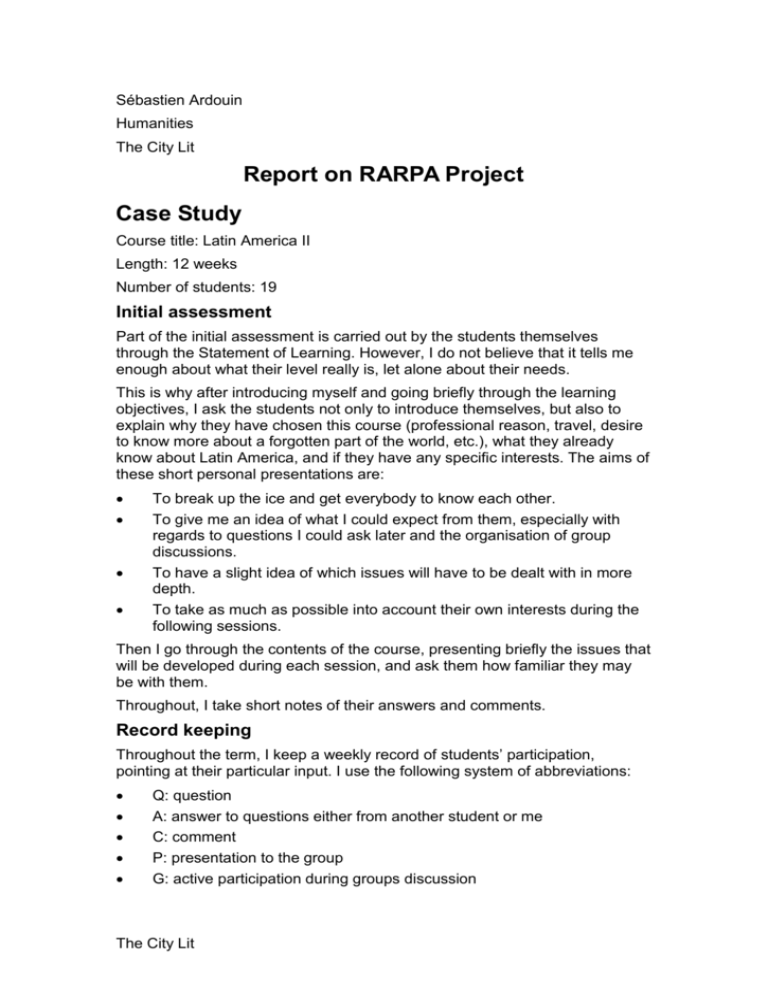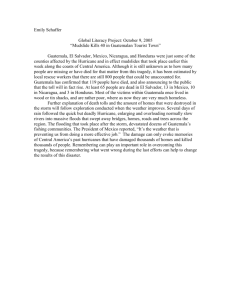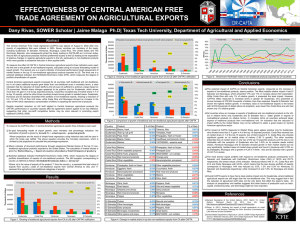City Lit Adult College: An Individual Tutor`s
advertisement

Sébastien Ardouin Humanities The City Lit Report on RARPA Project Case Study Course title: Latin America II Length: 12 weeks Number of students: 19 Initial assessment Part of the initial assessment is carried out by the students themselves through the Statement of Learning. However, I do not believe that it tells me enough about what their level really is, let alone about their needs. This is why after introducing myself and going briefly through the learning objectives, I ask the students not only to introduce themselves, but also to explain why they have chosen this course (professional reason, travel, desire to know more about a forgotten part of the world, etc.), what they already know about Latin America, and if they have any specific interests. The aims of these short personal presentations are: To break up the ice and get everybody to know each other. To give me an idea of what I could expect from them, especially with regards to questions I could ask later and the organisation of group discussions. To have a slight idea of which issues will have to be dealt with in more depth. To take as much as possible into account their own interests during the following sessions. Then I go through the contents of the course, presenting briefly the issues that will be developed during each session, and ask them how familiar they may be with them. Throughout, I take short notes of their answers and comments. Record keeping Throughout the term, I keep a weekly record of students’ participation, pointing at their particular input. I use the following system of abbreviations: Q: question A: answer to questions either from another student or me C: comment P: presentation to the group G: active participation during groups discussion The City Lit R: recommends some reading or tells the group about some particular event about Latin America (most of this is actually done through e-mail) L (for later): any question or comment formulated after the class, either in the corridors or through e-mail Each abbreviation can then be followed by one to three stars. Even though this is quite straightforward, I only fill the form after the class. Doing it during the class would only distract me and the students, break the natural flow of the course and make us all lose precious time. Keeping records of students’ progress can actually be quite difficult, especially maybe for knowledge-based courses that deal with different topics every week, and for which there is no material such as homework or exam papers that can be used to monitor progress. After a while I notice that students are able to refer to previous classes in their questions or comments, in particular during group discussions, but this is not necessarily easily spotted. Also many students are sometimes not so keen on group discussions because they feel they do not have enough knowledge, in spite of their wide ranging experiences and of the reading they might have done to prepare for the course. Another method I have been using to assess students’ learning and progress is to send them every fortnight by e-mail short quizzes, usually with ten questions per session [see examples attached]. Most of them have actually sent them back, though not everybody. That was particularly the case if they could not come to the session the questions referred to. This is only possible because I strongly encourage them to get an e-mail address as I use e-mails on a weekly basis to distribute documents, send information about events and new books, answer questions, and whenever they could not come, send them the handouts I give each week. From next year though in addition to these small quizzes, I will give them a quiz with fairly general questions during the first week and give them the same one at the end of the course. Hopefully, their score will have improved! Statement of Learning The form itself Thirteen students have completed the “old” Statement of Learning form I have been using this year. The advantage of the forms, both “old” and “new”, is their overall simplicity and I think it should be kept that way. They are fairly straightforward and quick to fill. Two points seem to confuse the students though: The 1-4 scale used to measure their level. Even though it is explained on the form, some mistake a 1 for a 4, and the other way. Whether they should sign at the beginning of the course or the end. With regards to the scale, maybe using letters instead of numbers would clarify the system. The City Lit As for the signature, I have always told them that it did not matter that much as long as it was signed and that the columns were duly filled at the beginning and the end of the course. Over the past few years, relatively few students have filled the “Other Achievements” box. Maybe I did not emphasise enough the importance of this part of the form. Formative assessment As I used the “old” form, I did not have to carry any mid-course assessment. I believe that formative assessment is a positive addition to the Statement of Learning as it reminds students of the course’s outcomes and what they can expect from it, and encourages tutors to keep focused. However, I would favour a mid-course assessment carried out by the students instead of the tutor. Even though some students would almost always underevaluate themselves and a lower mark may actually be a sign of progress (because the person is more aware of the complexity of the issue than at the beginning and realises that his/her knowledge is not as deep as originally thought), this would give tutors a clear indication of how well learning outcomes have been covered so far, and if necessary to adjust their teaching. Obviously the problem is one of time, especially since it would take at last a couple of sessions to get all students to fill in the form, with at least ten minutes spent each week (quite a considerable amount when the class only lasts for one hour and a half). Learning Outcomes for self assessment Provided the Learning Outcomes are clearly formulated and the tutor explains them when presenting the course, I think they are a good way for students to carry out a quick self-assessment. Recommendations The only recommendations I would make concern: The form itself: to keep it simple and one-sided. Maybe increase a bit the size of the box “What do you hope to achieve from the course?” as it often gets cramped. The scale used to measure the students level: to use letters instead of numbers. This would also reduce the temptation to compile data and statistics from the form. The mid-course assessment: to be carried out by students instead of tutors. Also, it is essential to keep the Statement of Learning and the Course Evaluation on two separate forms. The City Lit Latin America II – Quiz No. 2 Name: You can either print the questionnaire and give it back to me (tick the right answer) or send it back by e-mail as an attachment. If you choose the second option, just add a “X” after the right answer. Other questionnaires will follow and who knows, the person with the highest score may well win something (any hope of getting a return flight to Latin America may well not be fulfilled!) 1. 2. 3. 4. 5. 6. The fictional town of Macondo is the setting of which Latin American novel? a. One Hundred Years of Solitude b. The Labyrinth of Solitude c. The Death of Artemio Cruz The revolt of Catholic landless peasants at Canudos in the 1890s is at the centre of which of the following books? a. The War of the End of the World b. Rebellion in the Backlands c. Time of the Heroes In Enrique Rodo’s Ariel, what is the figure of Caliban associated with? a. The indigenous civilisations of the Río de la Plata b. The forces of progress c. The United States and imperialism Which novel analyses the regime of Paraguayan dictator Dr. Francia? a. The Autumn of the Patriarch b. Reasons of the State c. I, the Supreme Associated by Domingo Faustino Sarmiento with barbarism, the Argentine gaucho was given positive attributes in which novel? a. Martín Fierro b. Don Segundo Sombra c. Facundo In which novel does Mario Vargas Llosa sharply criticises the Peruvian extreme Left and its strategy of revolutionary war? a. The Real Life of Alejandro Mayta b. Conversation at the Cathedral c. Death in the Andes The City Lit 7. Seven Interpretative Essays on Peruvian Reality, by José Carlos Mariátegui had a profound impact on the Latin American Left. What does the author claim in it? a. The Inca state was a prototype of socialist society b. Industrialisation, even limited as it is in Latin America, will lead to revolution c. 8. 9. The peasants form the true revolutionary class in Latin America Which writer used forms of popular culture such as cinema, telenovelas or songs in his novels, sometimes to critically reflect upon them? a. Manuel Puig b. José Donoso c. Jorge Luis Borges Osvaldo Soriano’s A Funny, Dirty Little War is a grotesque farce on: a. The fight between drug barons to control drug trafficking in Medellín b. The increasingly violent struggle between different factions of the Peronist movement in a small town of the Buenos Aires province c. The attempts by a group of young revolutionaries to capture an American businessman suspected of being the CIA’s man in their country 10. Which former Left wing writer distanced himself from Castro in the 1970s and embraced liberalism in the early 1980s? a. Carlos Fuentes b. Mario Vargas Llosa c. Gabrial García Márquez The City Lit Latin America II – Quiz No. 3 Name: You can either print the questionnaire and give it back to me (tick the right answer) or send it back by e-mail as an attachment. If you choose the second option, just add a “X” after the right. Other questionnaires will follow and who knows, the person with the highest score may well win something (any hope of getting a return flight to Latin America may well not be fulfilled!) 1. 2. 3. 4. 5. 6. Which “Monitoring Centre” was set up by the US in 2000 to check air traffic from Colombia? a. Balboa (Panama) b. San Pedro Sula (Honduras) c. Comalapa (El Salvador) Which Nicaraguan politician was murdered in 1956 in Managua? a. Anastasio “Tacho” Somoza García b. Augusto César Sandino c. Pedro Joaquín Chamorro In 1954, Colonel Carlos Castillo Armas led a coup against which Central American president? a. Jorge Ubico b. Jacobo Arbenz c. Juan José Arévalo In which country did the guerrilla of the Farabundo Martí National Liberation Front operate? a. Honduras b. El Salvador c. Nicaragua Which two countries fought the so-called “football war” in 1969? a. Costa Rica and Nicaragua b. Honduras and Guatemala c. El Salvador and Honduras How did Richard Nixon once famously call Anastasio Somoza? a. The best man ever to govern Nicaragua b. A great defensor of freedom and democracy c. A son of a bitch The City Lit 7. 8. 9. Which president won the Nobel Peace Prize for his efforts to put an end to the cival wars in Central America? a. Oscar Arias (Costa Rica) b. José Napoleón Duarte (El Salvador) c. Jorge Serrano (Guatemala) What was the alleged purpose of Operation Just Cause? a. To arrest Panamean president Manuel Noriega b. To defend the US citizens living on Grenada c. To channel illegal resources to the Contra Which countries of the Caribbean basin have so far signed the Central American Free Trade Area treaty? a. Guatemala, Belize, El Salvador, Honduras, Costa Rica, and Nicaragua b. Guatemala, El Salvador, Honduras, Nicaragua, Costa Rica, and Santo Domingo c. Rica Guatemala, El Salvador, Honduras, Nicaragua, and Costa 10. How does the combined GDP of the countries part of CAFTA compare with the US’s? a. 0.5% b. 2.2% c. 3.4% The City Lit











